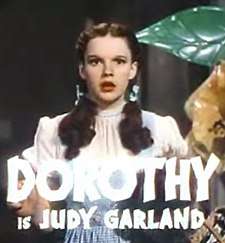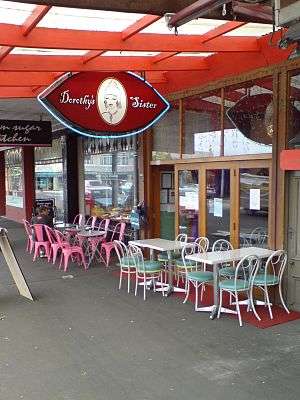Friend of Dorothy

In gay slang, a "friend of Dorothy" (occasionally abbreviated FOD) is a gay man.[1] The phrase dates back to at least World War II, when homosexual acts were illegal in the United States. Stating that, or asking if, someone was a "friend of Dorothy" was a euphemism used for discussing sexual orientation without others knowing its meaning. A similar term, "friend of Mrs. King" (i.e. Queen, in the meaning of 'gay man') was used in England, mostly in the first half of the 20th century.[2]
Origins
The precise origin of the term is unknown. Some believe that it is derived from The Road to Oz (1909), a sequel to the original Wonderful Wizard of Oz. The book introduces readers to Polychrome who, upon meeting Dorothy's travelling companions, exclaims, "You have some queer friends, Dorothy", and she replies, "The queerness doesn't matter, so long as they're friends."[3] More commonly, it is stated that "friend of Dorothy" refers to the film The Wizard of Oz because Judy Garland, who starred as the main character Dorothy, is a gay icon. In the film, Dorothy is accepting of those who are different. For example, the "gentle lion" giving the line, "I'm afraid there's no denyin', I'm just a dandy lion."[4][5]
In many of the original Oz books there are some LGBT-friendly plots. In the first book Dorothy admits to a crush on the China Princess. Ozma was transformed into a boy and her memories erased for most of her life. An all-female army attempted to conquer Oz. Ozma essentially marries Dorothy in book six making her a princess of Oz and her longtime companion. There are several creatures, including air elementals and some sorceresses which appear only in female groups. Glinda, the good witch, lives in a castle along with 100 of the most beautiful women in Oz who greet Dorothy and Ozma when they visit with kisses and dance for their amusement.
Misunderstanding
In the early 1980s, the Naval Investigative Service was investigating homosexuality in the Chicago area. Agents discovered that gay men sometimes referred to themselves as "friends of Dorothy". Unaware of the historical meaning of the term, the NIS believed that there actually was a woman named Dorothy at the center of a massive ring of homosexual military personnel, so they launched an enormous and futile hunt for the elusive "Dorothy", hoping to find her and convince her to reveal the names of gay service members.[6]
Current usage
Starting in the late 1980s, on several cruise lines, gay and lesbian passengers began approaching ship staff, asking them to publicise gatherings in the daily cruise activity list. As the cruise lines were hesitant to announce such things so blatantly in their daily publications, they would list the gathering as a "Meeting of the Friends of Dorothy".[7] The use of this phrase likely comes from the cruise directors who were also familiar with and using the "Friends of Bill W." phrase in their programs to tell members of Alcoholics Anonymous that there were support group meetings on the trip.
Such meetings have expanded in popularity and frequency over the years. Now, many cruise lines will have multiple FOD events, sometimes as many as one each night.[8] Despite this, many FOD meetings have low turnout rates.[9]
See also
Further reading
- Chauncey, George (1994). Gay New York: Gender, Urban Culture, and the Makings of the Gay Male World, 1890–1940. New York: Basic Books.
- Duberman, Martin (1993). Stonewall. New York: Dutton. Lesbian and gay life before and after Stonewall, as seen by six contemporaries.
- Duberman, Martin, Martha Vicinus, and George Chauncey, Jr. (eds) (1989). Hidden From History: Reclaiming the Gay and Lesbian Past. New York: NAL Books. Twenty-nine essays covering aspects of the gay and lesbian world from ancient to contemporary times.
- Grahn, Judy (1990). Another Mother Tongue: Gay Words, Gay Worlds. Boston: Beacon Press. Explores the use of language to define gay and lesbian culture by examining stereotypes as access points into history.
- Katz, Jonathan (1992). Gay American History: Lesbians and Gay Men in the U.S.A.: a Documentary History. Rev. Ed. New York: Meridian.
- Marcus, Eric (1992). Making History: The Struggle for Gay and Lesbian Equal Rights, 1945–1990: An Oral History. New York: HarperCollins.
References
- ↑ Leap, William; Tom Boellstorff (2003). Speaking in Queer Tongues: Globalization and Gay Language. University of Illinois Press. p. 98. ISBN 0-252-07142-5.
- ↑ Richardson, John (1999). "The Sorcerer's Apprentice". The New York Times.
- ↑
- ↑ Brantley, Ben (June 28, 1994). "Why Oz Is a State of Mind In Gay Life and Drag Shows". The New York Times. p. C.1.
- ↑ Paglia, Camille (June 14, 1998). "Judy Garland As a Force Of Nature". The New York Times.
- ↑ Shilts, Randy (1993). Conduct Unbecoming: Gays & Lesbians in the U.S. Military. Google Books. New York City, New York: St. Martin's Press. p. 387. ISBN 0-312-34264-0.
- ↑ "FOD FAQ's, or Who Are the Friends of Dorothy? - Cruise Critic". Retrieved 18 October 2016.
- ↑ Guaracino, Jeff (2007). Gay and lesbian tourism : the essential guide for marketing (1st ed.). Amsterdam: Elsevier/Butterworth-Heinemann. ISBN 0-7506-8232-9.
- ↑ "FOD FAQ's, or Who Are the Friends of Dorothy?". Cruise Critic. Retrieved 2016-05-06.
